Ortiz de Montellano Paul R.(Ed.) Cytochrome P450. Structure, Mechanism, and Biochemistry
Подождите немного. Документ загружается.

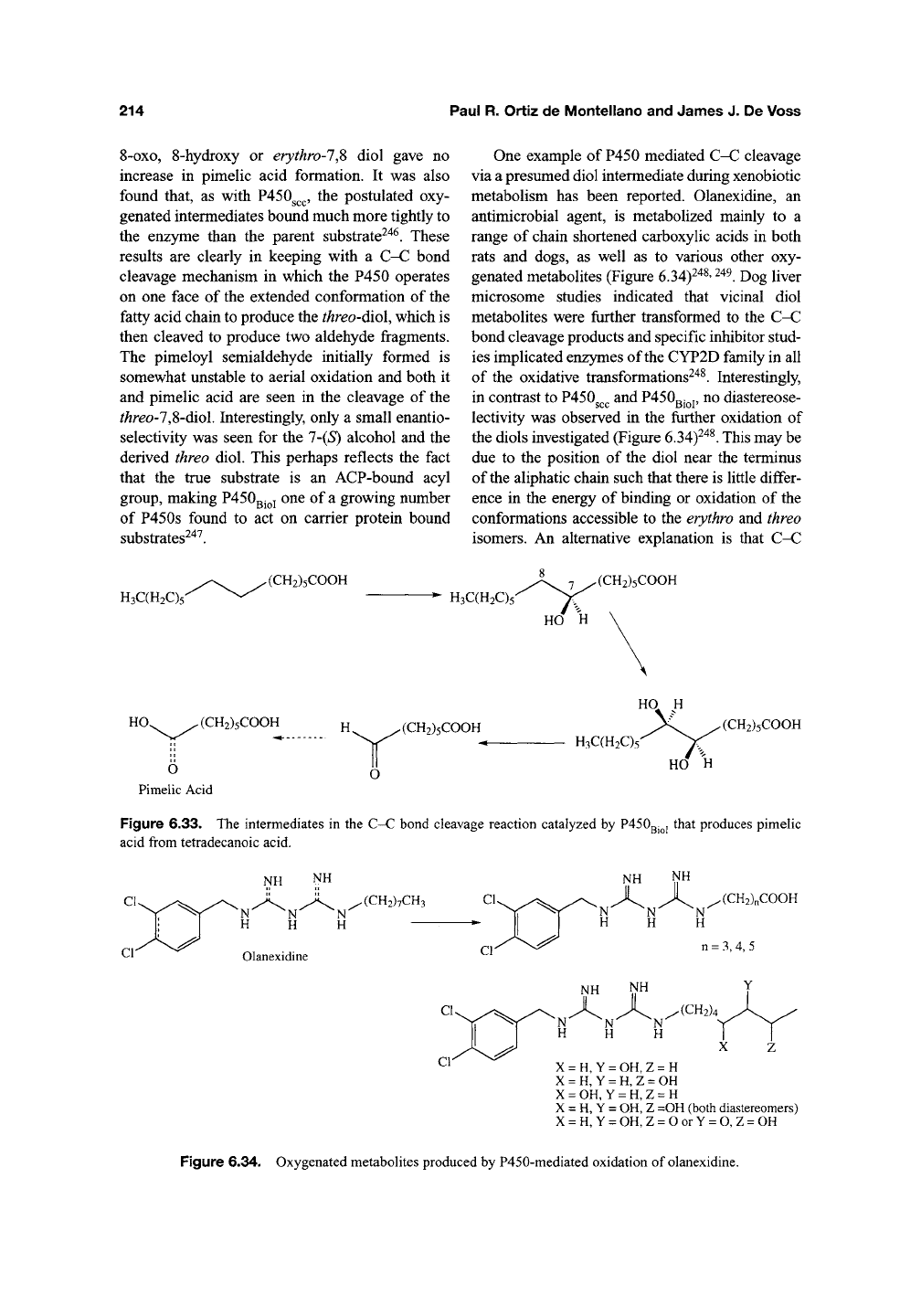
214
Paul
R.
Ortiz
de
Montellano
and
James
J. De
Voss
8-0X0, 8-hydroxy or erythro-1,% diol gave no
increase in pimelic acid formation. It was also
found that, as with P450g^^,, the postulated oxy-
genated intermediates bound much more tightly to
the enzyme than the parent substrate^"^^. These
results are clearly in keeping with a C-C bond
cleavage mechanism in which the P450 operates
on one face of the extended conformation of the
fatty acid chain to produce the threo-diol, which is
then cleaved to produce two aldehyde fragments.
The pimeloyl semialdehyde initially formed is
somewhat unstable to aerial oxidation and both it
and pimelic acid are seen in the cleavage of the
threo'7,S'dio\. Interestingly, only a small enantio-
selectivity was seen for the 7-(«S) alcohol and the
derived threo diol. This perhaps reflects the fact
that the true substrate is an ACP-bound acyl
group, making
P450QJ^J
one of a growing number
of P450s found to act on carrier protein bound
substrates^"^^.
One example of P450 mediated C-C cleavage
via a presumed diol intermediate during xenobiotic
metabolism has been reported. Olanexidine, an
antimicrobial agent, is metabolized mainly to a
range of chain shortened carboxylic acids in both
rats and dogs, as well as to various other oxy-
genated metabolites (Figure 6.34)^^^'
^^^.
Dog liver
microsome studies indicated that vicinal diol
metabolites were further transformed to the C-C
bond cleavage products and specific inhibitor stud-
ies implicated enzymes of the CYP2D family in all
of the oxidative transformations^'*^. Interestingly,
in contrast to P450^^^ and
P450QJ^J,
no diastereose-
lectivity was observed in the further oxidation of
the diols investigated (Figure
6.34)^"*^.
This may be
due to the position of the diol near the terminus
of the aliphatic chain such that there is little differ-
ence in the energy of binding or oxidation of the
conformations accessible to the erythro and threo
isomers. An alternative explanation is that C-C
.(CH2)5COOH
H3C(H2C)5"
H3C(H2C)5
(CH2)5COOH
HO H
HO H
HO.
.(CH2)5COOH
O
Pimelic Acid
(CH2)5COOH
H3C(H2C)5
(CH2)5COOH
HO H
Figure 6.33. The intermediates in the C-C bond cleavage reaction catalyzed by P450gj^, that produces pimelic
acid from tetradecanoic acid.
NH NH
(CH2)7CH3
CI
Olanexidine
CI
CI
CI
NH NH
J<^
JK^ ^(CH2)nCOOH
NH NH
n
=
3, 4,
5
Y
"N'
H
.(CH2)4
X
X =
H,
Y =
OH,
Z
=
H
X
=
H, Y
=
H,
Z
=
OH
X =
OH,
Y =
H,
Z
=
H
X = H, Y = OH, Z =OH (both diastereomers)
X =
H, Y
=
OH,
Z = O or
Y = O,
Z
=
OH
Figure 6.34. Oxygenated metabolites produced by P450-mediated oxidation of
olanexidine.
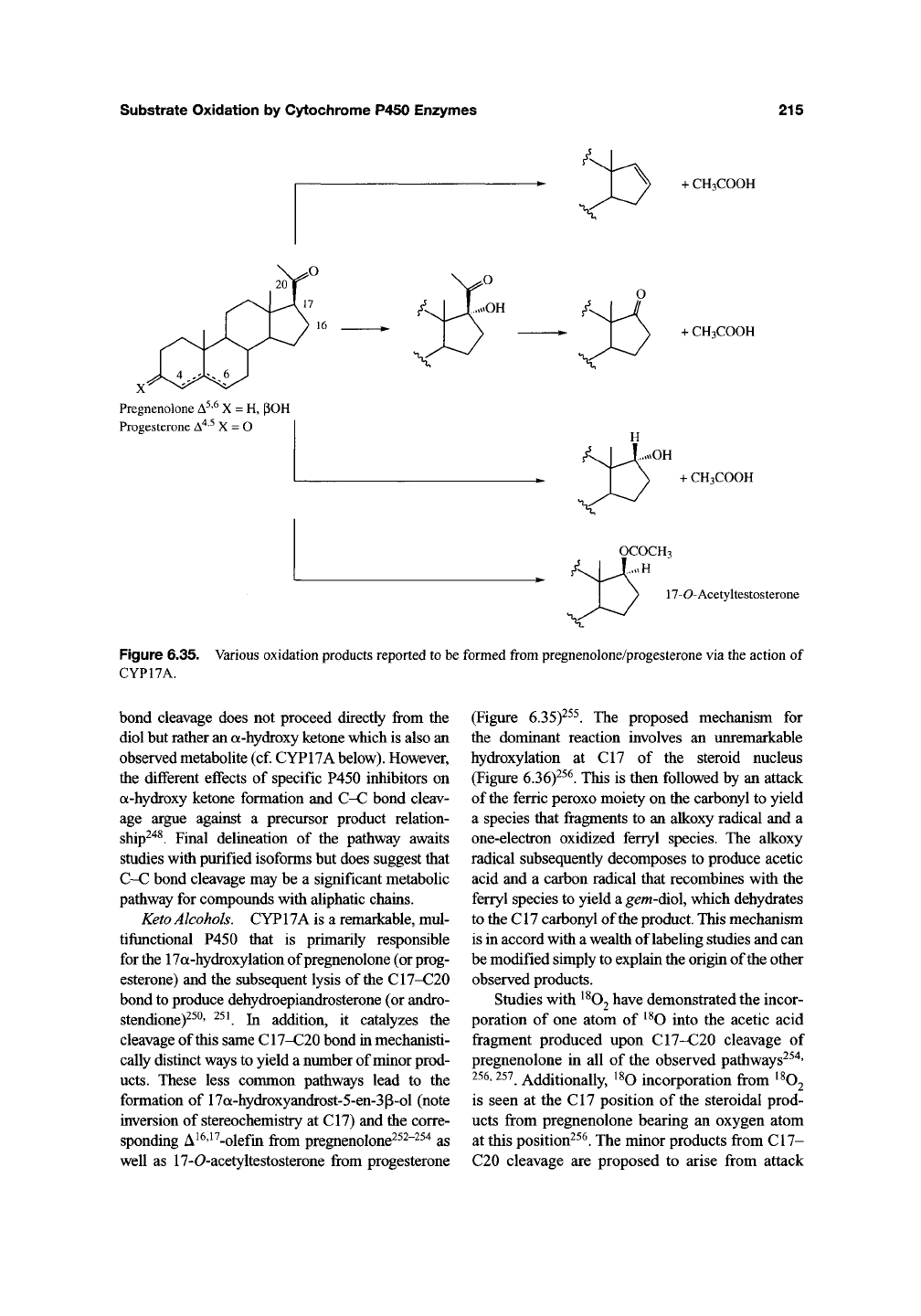
Substrate Oxidation by Cytochrome P450 Enzymes 215
X
jy-
CH3COOH
O
CH3COOH
Pregnenolone
A^'^
X =
H,
pOH
Progesterone
A"*'^
X = O
n
/vjJL..OH
_^ 1^ \
+
CH3COOH
V
_-^.
OCOCH3
17-0-Acetyltestosterone
Figure 6.35. Various oxidation products reported to be formed
from
pregnenolone/progesterone via the action of
CYP17A.
bond cleavage does not proceed directly from the
diol but rather an
a-hydroxy
ketone which is also an
observed metabolite (cf. CYP17A
below).
However,
the different effects of specific P450 inhibitors on
a-hydroxy
ketone formation and C-C bond cleav-
age argue against a precursor product relation-
ship^"^^.
Final delineation of the pathway awaits
studies with purified isoforms but does suggest that
C-C bond cleavage may be a significant metabolic
pathway for compounds with aliphatic chains.
Keto Alcohols. CYP17A is a remarkable, mul-
tifunctional P450 that is primarily responsible
for
the
17a-hydroxylation of pregnenolone (or prog-
esterone) and the subsequent lysis of
the
C17-C20
bond to produce dehydroepiandrosterone (or andro-
stendione)^^^' ^^^ In addition, it catalyzes the
cleavage of this same C17-C20 bond in mechanisti-
cally distinct ways to yield a number of minor prod-
ucts.
These less common pathways lead to the
formation of 17a-hydroxyandrost-5-en-3p-ol (note
inversion of stereochemistry at CI7) and the corre-
sponding A ^^'^ ^-olefin from pregnenolone^^^"^^^ as
well as 17-0-acetyltestosterone from progesterone
(Figure 6.35)-^^^. The proposed mechanism for
the dominant reaction involves an unremarkable
hydroxylation at CI7 of the steroid nucleus
(Figure 6.36)^^^. This is then followed by an attack
of the ferric peroxo moiety on the carbonyl to yield
a species that fragments to an alkoxy radical and a
one-electron oxidized ferryl species. The alkoxy
radical subsequently decomposes to produce acetic
acid and a carbon radical that recombines with the
ferryl species to yield a
gem-dio\,
which dehydrates
to the C17 carbonyl of the product. This mechanism
is in accord with a wealth of labeling studies and can
be modified simply to explain the origin of the other
observed products.
Studies with ^^62 have demonstrated the incor-
poration of one atom of ^^O into the acetic acid
fragment produced upon C17-C20 cleavage of
pregnenolone in all of the observed pathways^^^'
256,257 Additionally, ^^O incorporation from ^^03
is seen at the C17 position of the steroidal prod-
ucts from pregnenolone bearing an oxygen atom
at this position^^^. The minor products from C17-
C20 cleavage are proposed to arise from attack

216 Paul R. Ortiz de Montellano and James J. De Voss
•O—Fe(IlI)
CH3COOH
Figure 6.36. Proposed mechanism for the C17-C20 lyase reaction catalyzed by CYP17A. The key steps involve
addition of a P450 ferric peroxide species to the C20 carbonyl and subsequent free radical fragmentation of the
peroxyhemiacetal.
,..xOH
iO'
(J 'O—Fe(III) /
•O—Fe(III)
+ CH3COOH
V
17-(9-Acety Itestosterone
':b
Figure 6.37. Proposed mechanistic manifold to account for the formation of other products in the CYP17A
catalyzed oxidation of pregnenolone/progesterone. Ionic decomposition (pathway b) of the peroxyhemiacetal
competes with free-radical fragmentation (pathway a) to yield the observed mixture of minor products.
of the ferric peroxo species on the carbonyl prior
to any C17 hydroxylation (Figure 6.37). The
resultant adduct then fragments to an alkoxy radi-
cal which loses acetic acid to produce a C17 radi-
cal in a fashion analogous to that proposed for the
major pathway. This C17 radical then partitions
between direct oxygen rebound to the 17a-
hydroxy product and elimination
to
the A ^^'^ ^-olefin.
This latter product may arise via direct hydrogen
abstraction or via a single-electron oxidation of the
radical to the cation followed by elimination of a
proton^^^. Results of CYP17A catalyzed oxidation
of substrates bearing deuterium labels at the CI6,
C17 and the methyl group a to the ketone are in
agreement with this mechanism^^^. The 17-0-
acetyl-testosterone is probably best explained as
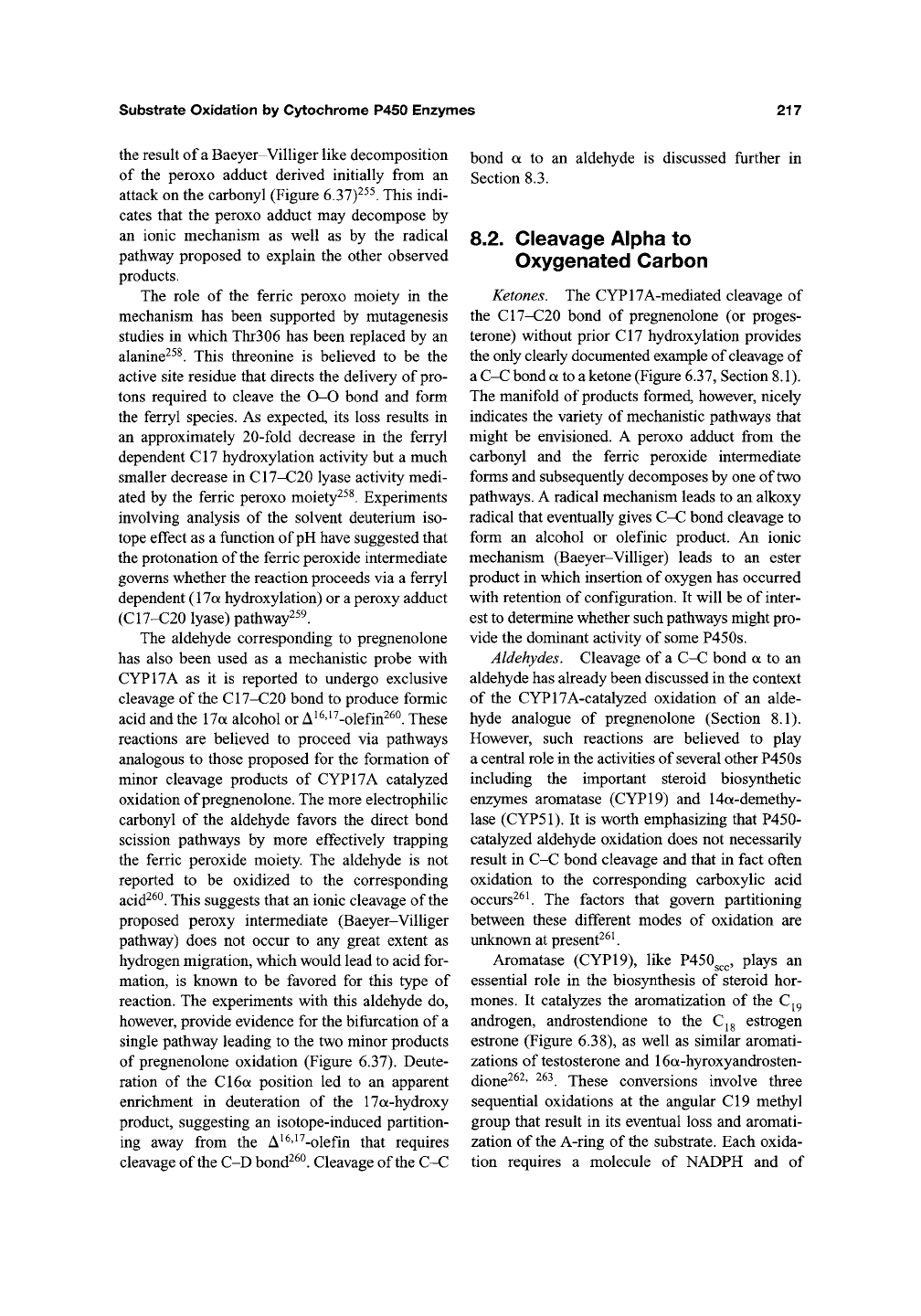
Substrate Oxidation by Cytochrome P450 Enzymes
217
the result of a Baeyer-Villiger like decomposition
of the peroxo adduct derived initially from an
attack on the carbonyl (Figure 6.37)^^^. This indi-
cates that the peroxo adduct may decompose by
an ionic mechanism as well as by the radical
pathway proposed to explain the other observed
products.
The role of the ferric peroxo moiety in the
mechanism has been supported by mutagenesis
studies in which Thr306 has been replaced by an
alanine^^^. This threonine is believed to be the
active site residue that directs the delivery of pro-
tons required to cleave the O-O bond and form
the ferryl species. As expected, its loss results in
an approximately 20-fold decrease in the ferryl
dependent C17 hydroxylation activity but a much
smaller decrease in C17-C20 lyase activity medi-
ated by the ferric peroxo moiety^^^. Experiments
involving analysis of the solvent deuterium iso-
tope effect as a function of pH have suggested that
the protonation of the ferric peroxide intermediate
governs whether the reaction proceeds via a ferryl
dependent (17a hydroxylation) or a peroxy adduct
(C17-C20 lyase) pathway259.
The aldehyde corresponding to pregnenolone
has also been used as a mechanistic probe with
CYP17A as it is reported to undergo exclusive
cleavage of the C17-C20 bond to produce formic
acid and the 17a alcohol or A^^'^^-olefin^^^. These
reactions are believed to proceed via pathways
analogous to those proposed for the formation of
minor cleavage products of CYP17A catalyzed
oxidation of pregnenolone. The more electrophilic
carbonyl of the aldehyde favors the direct bond
scission pathways by more effectively trapping
the ferric peroxide moiety. The aldehyde is not
reported to be oxidized to the corresponding
acid^^^. This suggests that an ionic cleavage of the
proposed peroxy intermediate (Baeyer-Villiger
pathway) does not occur to any great extent as
hydrogen migration, which would lead to acid for-
mation, is known to be favored for this type of
reaction. The experiments with this aldehyde do,
however, provide evidence for the bifurcation of a
single pathway leading to the two minor products
of pregnenolone oxidation (Figure 6.37). Deute-
ration of the CI6a position led to an apparent
enrichment in deuteration of the 17a-hydroxy
product, suggesting an isotope-induced partition-
ing away from the A ^^'^ ^-olefin that requires
cleavage of the C-D
bond^^o.
Cleavage of the C-C
bond a to an aldehyde is discussed further in
Section 8.3.
8.2. Cleavage Alpha to
Oxygenated Carbon
Ketones. The CYP17A-mediated cleavage of
the C17-C20 bond of pregnenolone (or proges-
terone) without prior CI7 hydroxylation provides
the only clearly documented example of cleavage of
a C-C bond a to a ketone (Figure 6.37, Section 8.1).
The manifold of products formed, however, nicely
indicates the variety of mechanistic pathways that
might be envisioned. A peroxo adduct fi*om the
carbonyl and the ferric peroxide intermediate
forms and subsequently decomposes by one of two
pathways. A radical mechanism leads to an alkoxy
radical that eventually gives C-C bond cleavage to
form an alcohol or olefinic product. An ionic
mechanism (Baeyer-Villiger) leads to an ester
product in which insertion of oxygen has occurred
with retention of configuration. It will be of inter-
est to determine whether such pathways might pro-
vide the dominant activity of some P450s.
Aldehydes. Cleavage of a C-C bond a to an
aldehyde has already been discussed in the context
of the CYP17A-catalyzed oxidation of an alde-
hyde analogue of pregnenolone (Section 8.1).
However, such reactions are believed to play
a central role in the activities of several other P450s
including the important steroid biosynthetic
enzymes aromatase (CYP19) and 14a-demethy-
lase (CYP51). It is worth emphasizing that P450-
catalyzed aldehyde oxidation does not necessarily
result in C-C bond cleavage and that in fact often
oxidation to the corresponding carboxylic acid
occurs^^^ The factors that govern partitioning
between these different modes of oxidation are
unknown at present^^^.
Aromatase (CYP19), like P450g^^, plays an
essential role in the biosynthesis of steroid hor-
mones. It catalyzes the aromatization of the C^^
androgen, androstendione to the C^g estrogen
estrone (Figure 6.38), as well as similar aromati-
zations of testosterone and 16a-hyroxyandrosten-
dione^^^' ^^^. These conversions involve three
sequential oxidations at the angular C19 methyl
group that result in its eventual loss and aromati-
zation of the A-ring of the substrate. Each oxida-
tion requires a molecule of NADPH and of

218
Paul R. Ortiz de Montellano and James J. De Voss
Ha Hp
HO,
oA^,
HO OH
V
o^^^,
Androstendione
O^ H
V
Estrogen
Figure 6.38. Intermediates in the catalytic turnover of aromatase (CYP19).
/
oxygen^^'*. The first two steps appear to be unex-
ceptional P450-catalyzed hydroxylation steps. The
initial reaction produces the CI9 primary alcohol
and proceeds, as expected, with retention of
configuration^^^' ^^^, while the second oxidation
abstracts the \9-pro-R hydrogen to yield a gem-
diol intermediate^^^' ^^^. This latter compound is
believed to dehydrate to yield the more stable,
observed C19 aldehyde. There is an observable
tritium isotope effect on the first hydroxylation
step^^^,
but not on the subsequent one with [19-^H]
androst-4-ene-3,17-dione or analogues^^^' ^^^
This is understandable as the first step can dis-
criminate between the hydrogen and tritium atoms
on a given methyl group. An isotope effect on the
second step, however, which stereospecifically
removes the pro-R hydrogen, would require the
kind of /«/er-molecular effect commonly sup-
pressed in P450 reactions. It is the mechanism of
the third oxidative transformation that involves
C-C bond cleavage and aromatization that has
attracted the most attention. In this reaction, the ip
and
2(3
hydrogens are lost^^^~^^^ into water and the
CI9 carbon as formate which contains an oxygen
atom from the first and third oxidation
steps^^^'
^^^.
A large number of different mechanisms have been
proposed to account for this transformation involv-
ing the intermediacy of
a
steroid containing a C19
formyl group and, variously, a 4,5-epoxide^^^,
a ip-hydroxyl276, a 2p-hydroxyl ^su
282^
^^ ^ ^9
peroxide ^^^' ^^^ as well as a possible enzymic
Schiff base formed from the
3-keto
moiety^^"^.
Several of these intermediates are known to be
converted spontaneously^^
^
or by aromatase^^^ into
estrone but none of them are currently accepted as
lying upon the major pathway for aromatization.
This is primarily due to the '^O labeling studies
indicating that the third oxygen atom is incorpo-
rated into formate^^^'
^^^.
The difficulties in estab-
lishing the mechanism are illustrated nicely with
the postulated 2p-hydroxy intermediate. This was
synthesized and shown to aromatize rapidly in the
absence of enzyme^^' and it was also detected in
enzymic incubations at low pH (which slows the
aromatization reaction)^^^. However, the facts that
the 2p-hydroxyl was not incorporated into the
released formate^^^, and the stereochemistry of
loss of hydrogen from C-2 appears to be substrate
dependent ruled this compound out as an obliga-
tory intermediate^^^' ^^^. The currently accepted
mechanism^^^' 288-290 explains all experimental
observations and is supported by model stud-
jgg291-293
^j^^
analogy with the mechanisms of
other P450s such as CYP17A and CYP2B4 {vide
infra)
(Figure 6.39). Thus, the ferric peroxide inter-
mediate is believed to add to the electrophilic alde-
hyde carbonyl to yield a peroxyhemiacetal. This
can fragment to give an alkoxy radical that loses
formic acid to produce a CIO radical. Loss of the
ip hydrogen and enolization of the carbonyl is
required to produce the aromatized A ring. Recent
model studies by Valentine and coworkers provide
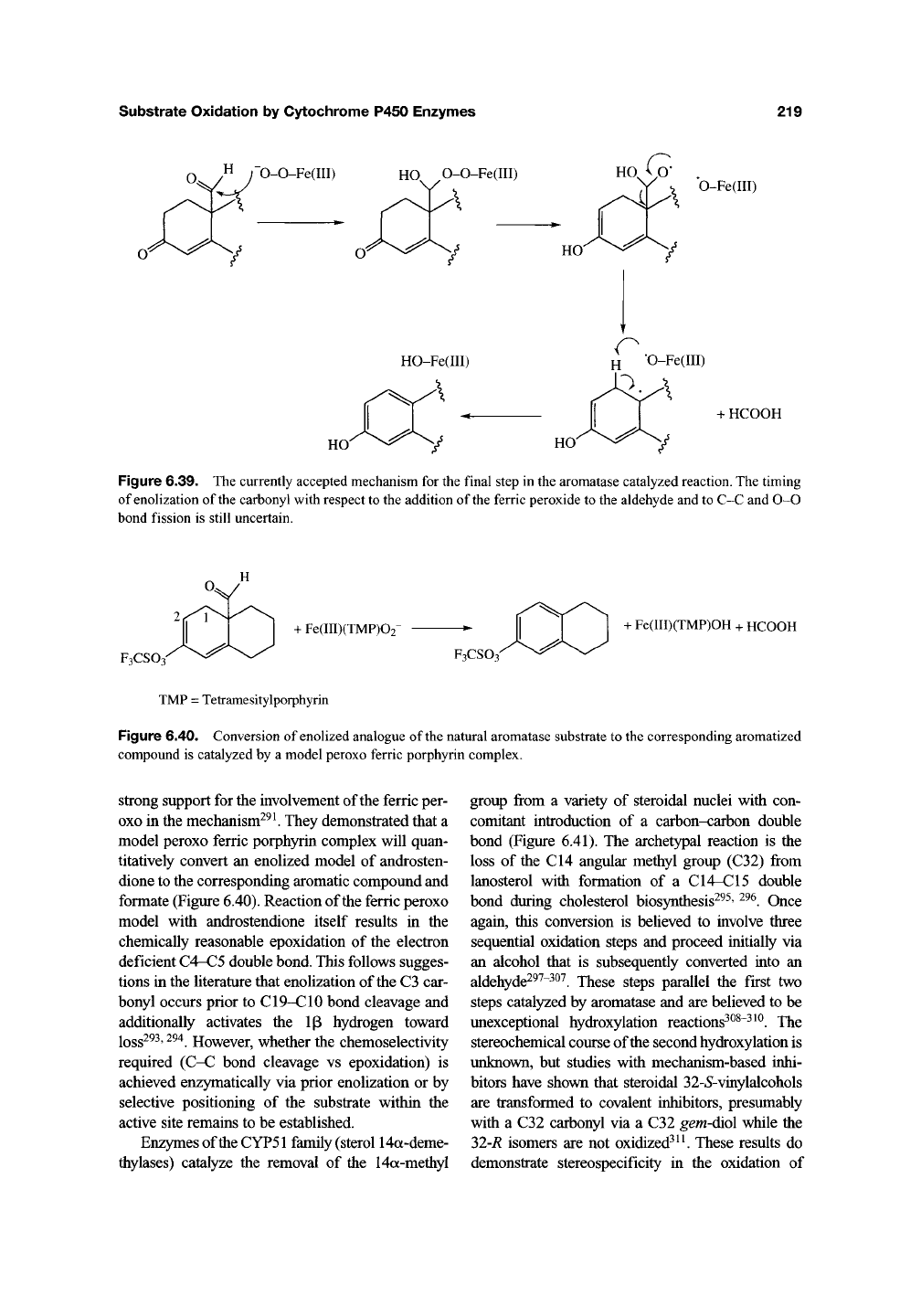
Substrate Oxidation by Cytochrome P450 Enzymes
219
H , O-O-Fe(III)
HO O-O-Fe(III)
V^ c O-Fe(III)
+ HCOOH
Figure 6.39. The currently accepted mechanism for the final step in the aromatase catalyzed reaction. The timing
of enolization of the carbonyl with respect to the addition of the ferric peroxide to the aldehyde and to C-C and 0-0
bond fission is still uncertain.
«^
+ Fe(III)(TMP)02"
F3CSO3'
TMP = Tetramesitylporphyrin
F3CSO3
+ Fe(III)(TMP)OH + HCOOH
Figure 6.40. Conversion of enolized analogue of the natural aromatase substrate to the corresponding aromatized
compound is catalyzed by a model peroxo ferric porphyrin complex.
strong support for the involvement of the ferric per-
oxo in the mechanism^^^. They demonstrated that a
model peroxo ferric porphyrin complex will quan-
titatively convert an enolized model of androsten-
dione to the corresponding aromatic compound and
formate (Figure 6.40). Reaction of the ferric peroxo
model with androstendione itself results in the
chemically reasonable epoxidation of the electron
deficient C4-C5 double bond. This follows sugges-
tions in the literature that enolization of the C3 car-
bonyl occurs prior to C19-C10 bond cleavage and
additionally activates the ip hydrogen toward
loss^^^'
^^^.
However, whether the chemoselectivity
required (C-C bond cleavage vs epoxidation) is
achieved enzymatically via prior enolization or by
selective positioning of the substrate within the
active site remains to be established.
Enzymes of the
CYP51
family (sterol 14a-deme-
thylases) catalyze the removal of the 14a-methyl
group from a variety of steroidal nuclei with con-
comitant introduction of a carbon-carbon double
bond (Figure 6.41). The archetypal reaction is the
loss of the C14 angular methyl group (C32) from
lanosterol with formation of a C14-C15 double
bond during cholesterol biosynthesis^^^' ^^^. Once
again, this conversion is believed to involve three
sequential oxidation steps and proceed initially via
an alcohol that is subsequently converted into an
aldehyde^^^"^^^. These steps parallel the first two
steps catalyzed by aromatase and are believed to be
unexceptional hydroxylation reactions^^^"^^^. The
stereochemical course of the second hydroxylation is
unknown, but studies with mechanism-based inhi-
bitors have shown that steroidal 32-5-vinylalcohols
are transformed to covalent inhibitors, presumably
with a C32 carbonyl via a C32 gem-diol while the
32-jR isomers are not oxidized^ ^^ These results do
demonstrate stereospecificity in the oxidation of
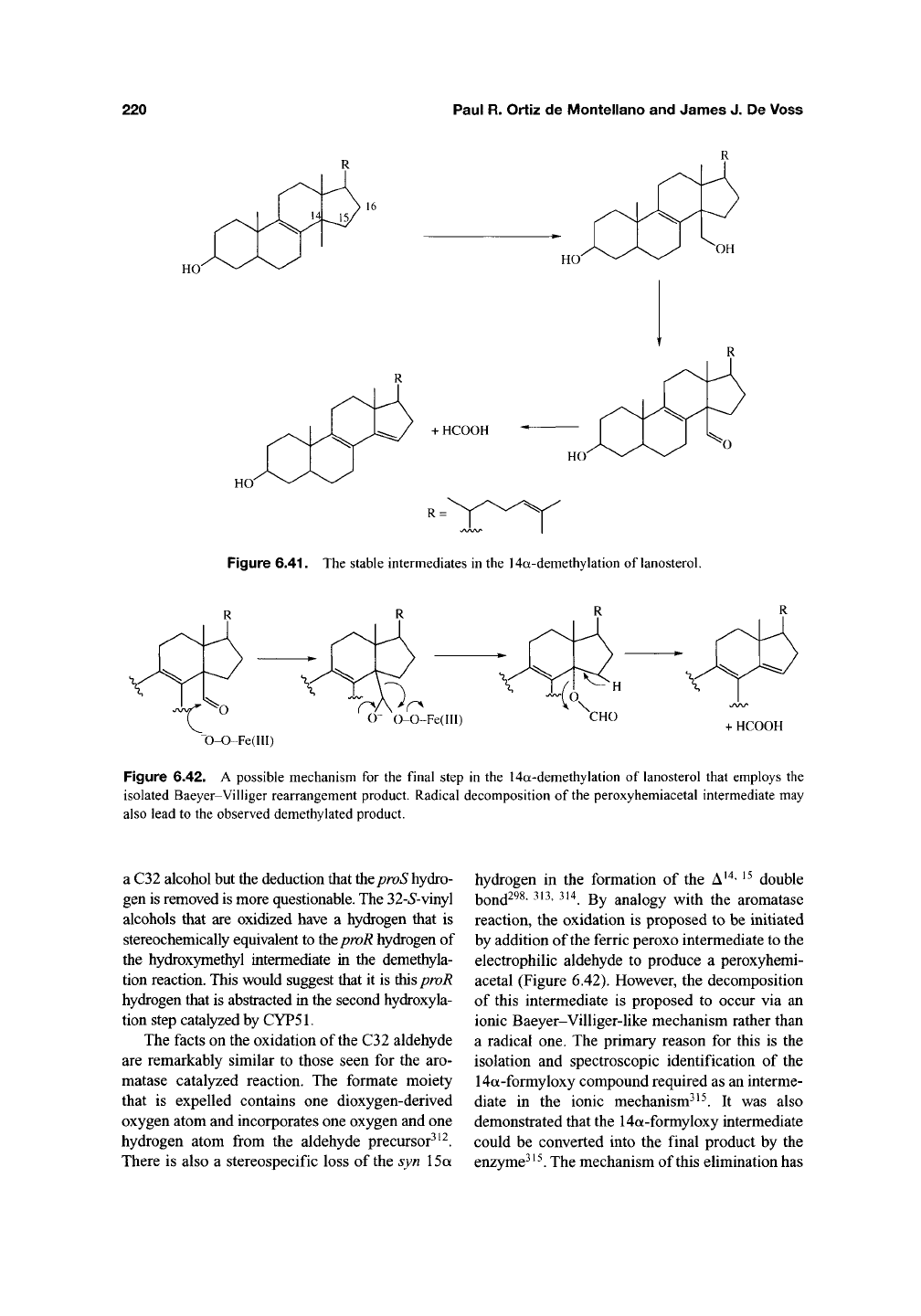
220 Paul R. Ortiz de Montellano and James J. De Voss
Figure 6.41. The stable intermediates in the 14a-demethylation of lanosterol.
+ HCOOH
Figure 6.42. A possible mechanism for the final step in the 14a-demethylation of lanosterol that employs the
isolated Baeyer-Villiger rearrangement product. Radical decomposition of the peroxyhemiacetal intermediate may
also lead to the observed demethylated product.
a C32 alcohol but the deduction that theproS hydro-
gen is removed is more questionable. The 32-»S'-vinyl
alcohols that are oxidized have a hydrogen that is
stereochemically equivalent to the proR hydrogen of
the hydroxymethyl intermediate in the demethyla-
tion reaction. This would suggest that it is
this
proR
hydrogen that is abstracted in the second hydroxyla-
tion step catalyzed by
CYP51.
The facts on the oxidation of the C32 aldehyde
are remarkably similar to those seen for the aro-
matase catalyzed reaction. The formate moiety
that is expelled contains one dioxygen-derived
oxygen atom and incorporates one oxygen and one
hydrogen atom from the aldehyde precursor^^^.
There is also a stereospecific loss of the syn 15a
hydrogen in the formation of the A'"^' ^^ double
bond^^^' 313,314 gy analogy with the aromatase
reaction, the oxidation is proposed to be initiated
by addition of the ferric peroxo intermediate to the
electrophilic aldehyde to produce a peroxyhemi-
acetal (Figure 6.42). However, the decomposition
of this intermediate is proposed to occur via an
ionic Baeyer-Villiger-like mechanism rather than
a radical one. The primary reason for this is the
isolation and spectroscopic identification of the
14a-formyloxy compound required as an interme-
diate in the ionic mechanism^^^. It was also
demonstrated that the 14a-formyloxy intermediate
could be converted into the final product by the
enzyme^
^^.
The mechanism of this elimination has
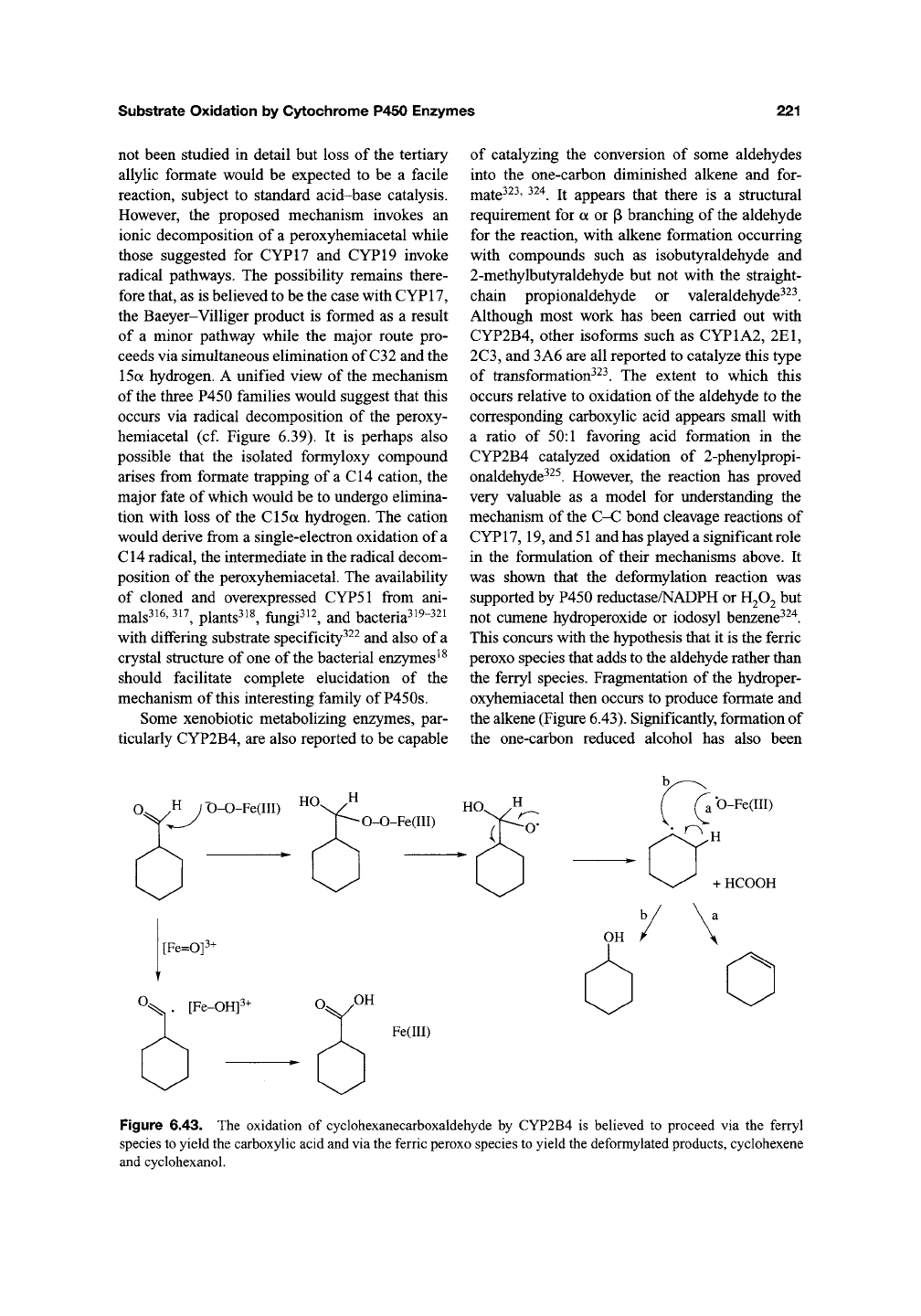
Substrate Oxidation by Cytochrome P450 Enzymes
221
not been studied in detail but loss of the tertiary
allylic formate would be expected to be a facile
reaction, subject to standard acid-base catalysis.
However, the proposed mechanism invokes an
ionic decomposition of a peroxyhemiacetal while
those suggested for CYP17 and CYP19 invoke
radical pathways. The possibility remains there-
fore that, as is believed to be the case with CYP17,
the Baeyer-Villiger product is formed as a result
of a minor pathway while the major route pro-
ceeds via simultaneous elimination of C32 and the
15a hydrogen. A unified view of the mechanism
of the three P450 families would suggest that this
occurs via radical decomposition of the peroxy-
hemiacetal (cf. Figure 6.39). It is perhaps also
possible that the isolated formyloxy compound
arises from formate trapping of a C14 cation, the
major fate of which would be to undergo elimina-
tion with loss of the CI5a hydrogen. The cation
would derive from a single-electron oxidation of
a
C14 radical, the intermediate in the radical decom-
position of the peroxyhemiacetal. The availability
of cloned and overexpressed CYP51 from ani-
mals^^^'
^^\ plants^i^
frmgi^^^,
and bacteria^^^-^^i
with differing substrate specificity^^^ and also of
a
crystal structure of one of the bacterial enzymes ^^
should facilitate complete elucidation of the
mechanism of
this
interesting family of P450s.
Some xenobiotic metabolizing enzymes, par-
ticularly CYP2B4, are also reported to be capable
of catalyzing the conversion of some aldehydes
into the one-carbon diminished alkene and for-
mate^^^' ^^^. It appears that there is a structural
requirement for a or p branching of the aldehyde
for the reaction, with alkene formation occurring
with compounds such as isobutyraldehyde and
2-methylbutyraldehyde but not with the straight-
chain propionaldehyde or valeraldehyde^^^.
Although most work has been carried out with
CYP2B4, other isoforms such as CYP1A2, 2E1,
2C3,
and 3A6 are all reported to catalyze this type
of transformation^^^. The extent to which this
occurs relative to oxidation of the aldehyde to the
corresponding carboxylic acid appears small with
a ratio of 50:1 favoring acid formation in the
CYP2B4 catalyzed oxidation of 2-phenylpropi-
onaldehyde^^^. However, the reaction has proved
very valuable as a model for understanding the
mechanism of the C-C bond cleavage reactions of
CYP17,19, and
51
and has played a significant role
in the formulation of their mechanisms above. It
was shown that the deformylation reaction was
supported by P450 reductase/NADPH or H2O2 but
not cumene hydroperoxide or iodosyl benzene^^"*.
This concurs with the hypothesis that it is the ferric
peroxo species that adds to the aldehyde rather than
the ferry
1
species. Fragmentation of the hydroper-
oxyhemiacetal then occurs to produce formate and
the alkene (Figure 6.43). Significantly, formation of
the one-carbon reduced alcohol has also been
O.^ /H , O-O-Fe(III)
O-O-Fe(III)
a*0-Fe(III)
+ HCOOH
[Fe=0]3
[Fe-OH]3
.OH
Fe(III)
Figure 6.43. The oxidation of cyclohexanecarboxaldehyde by CYP2B4 is believed to proceed via the ferryl
species to yield the carboxylic acid and via the ferric peroxo species to yield the deformylated products, cyclohexene
and cyclohexanol.

222
Paul
R.
Ortiz
de
Montellano
and
James
J. De
Voss
reported, although only m passing
!^^^
This product
is analogous to the 17a-hydroxy C^^ products
reported from CYP17A oxidation of pregnenolone
and its analogues. It should be noted that while
deformylation is thought to involve the ferric per-
0X0 species, oxidation to the acid is believed to pro-
ceed via the ferryl species^^^.
The relevance of the CYP2B4 catalyzed
deformylation reaction as a model for CYP51 is
clearly demonstrated by the aromatization of the
androstendione analogue 3-oxodecalin-4-ene-10-
carboxaldehyde to the corresponding tetrahydron-
aphthalene (cf Figure 6.40) with concomitant
formate production^^^' ^^^. Deuterium isotope
studies showed that the formyl hydrogen was
retained in the formate, that the
1
p hydrogen was
specifically lost, and that loss of
the
C2 hydrogen
was not stereoselective. These results faithfully
reproduce the characteristics of the aromatase cat-
alyzed reaction.
Recently, support for the role of ferric peroxo
species in CYP2B4 catalyzed deformylation, and
by analogy for the mechanisms of CYP17, -19,
and
-51,
has come from mutagenesis
studies^^^.
Vaz
and Coon reported the effect of replacing Thr302,
the residue thought to facilitate O-O bond cleavage
in CYP2B4, with alanine. It was expected that this
would favor the peroxo pathway and decrease the
availability of the ferryl species. In line with these
expectations, normal P450-catalyzed reactions,
including aldehyde to carboxylic acid oxidation,
were suppressed but deformylation to the alkene
and alcohol products was significantly enhanced^^^.
Evidence for
the
radical nature of the decomposition
of the peroxyhemiacetal has come from examination
of the mechanism-based inactivation of P450s that
occurs concurrently with aldehyde oxidation^^^' ^^^.
For saturated aldehydes, it was shown that inactiva-
tion of CYP2B4 paralleled their ability to undergo a
deformylation reaction, suggesting that both of
these processes flowed from a common intermedi-
ate,
the peroxyhemiacetal (Figure 6.43)^^^. It was
shown that inactivation of the P450 was due to addi-
tion of the carbon radical, formed in a homolytic
process, to the -y-meso position of the prosthetic
heme^^^. Interestingly, although
P450Q]^3
is reported
to oxidize a variety of aldehydes without detectable
deformylation^^ \ it was demonstrated that a mutant
is deactivated by aldehydes when the co-oxidant is
^2^2^^^'
This presumably again occurs through an
alkyl radical formed by homolytic decomposition of
the peroxyhemiacetal intermediate. An intermedi-
ate was detected in this work that was spectro-
scopically consistent with an isoporphyrin which
would be formed upon addition of a carbon radi-
cal to the heme cofactor^^^. Finally, it is of note
that the ferryl catalyzed oxidation of aldehydes to
acids can also cause enzyme inactivation by heme
adduct formation, but in this case as predicted for
an H abstraction mechanism, an acylated heme is
formed^^^.
Cytochrome P450s can also interact with alde-
hydes in a different way to generate the corre-
sponding hydrocarbon and
C02,^^^.
Hydrocarbons
are abundant components of cuticular lipids in
most insects and can also play a role in their
chemical communication. It has been demon-
strated that in microsomes derived from the house
fly, Musca domestica, hydrocarbons are formed
from the corresponding aldehyde with concomi-
tant generation of
CO2
and with all the character-
istics expected of
a
P450-mediated reaction:
CH3(CH2)8CH=CH(CH2)i2CD2CDO + NADPH
•
CH3(CH2)8CH=CH(CH2)i2CD3
^2 + H2C
+ O2 + H^
There is a requirement for NADPH and oxygen
and the reaction is inhibited by both CO and an
antibody to house fly P450 reductase^^^. Labeling
studies showed that deuterium atoms at the C-1,
C-2, and C-3 positions were all retained^^^ In
addition, active oxygen donors such as hydrogen
peroxide, cumene hydroperoxide, and iodosylben-
zene all support hydrocarbon production to some
extent. The ability of the latter species to support
oxidation clearly indicates that the ferric peroxide
species is not the active oxidant in this case. On
the basis of these results, an unusual mechanism
has been proposed^^' and a slightly more conven-
tional version is presented here (Figure 6.44). The
first step is the oxidation of the aldehyde to a
dioxirane or its resonance form, a carbonyl oxide.
Dioxiranes are known to decompose with release
of CO2 and formation of two radicals that can
recombine as shown to form a hydrocarbon^^^.
Presumably, this recombination would be favored
by retention of the fragments within the active
site.
Complete elucidation of the reaction mecha-
nism awaits identification and purification of the
P450 but recent studies have shown this to be a
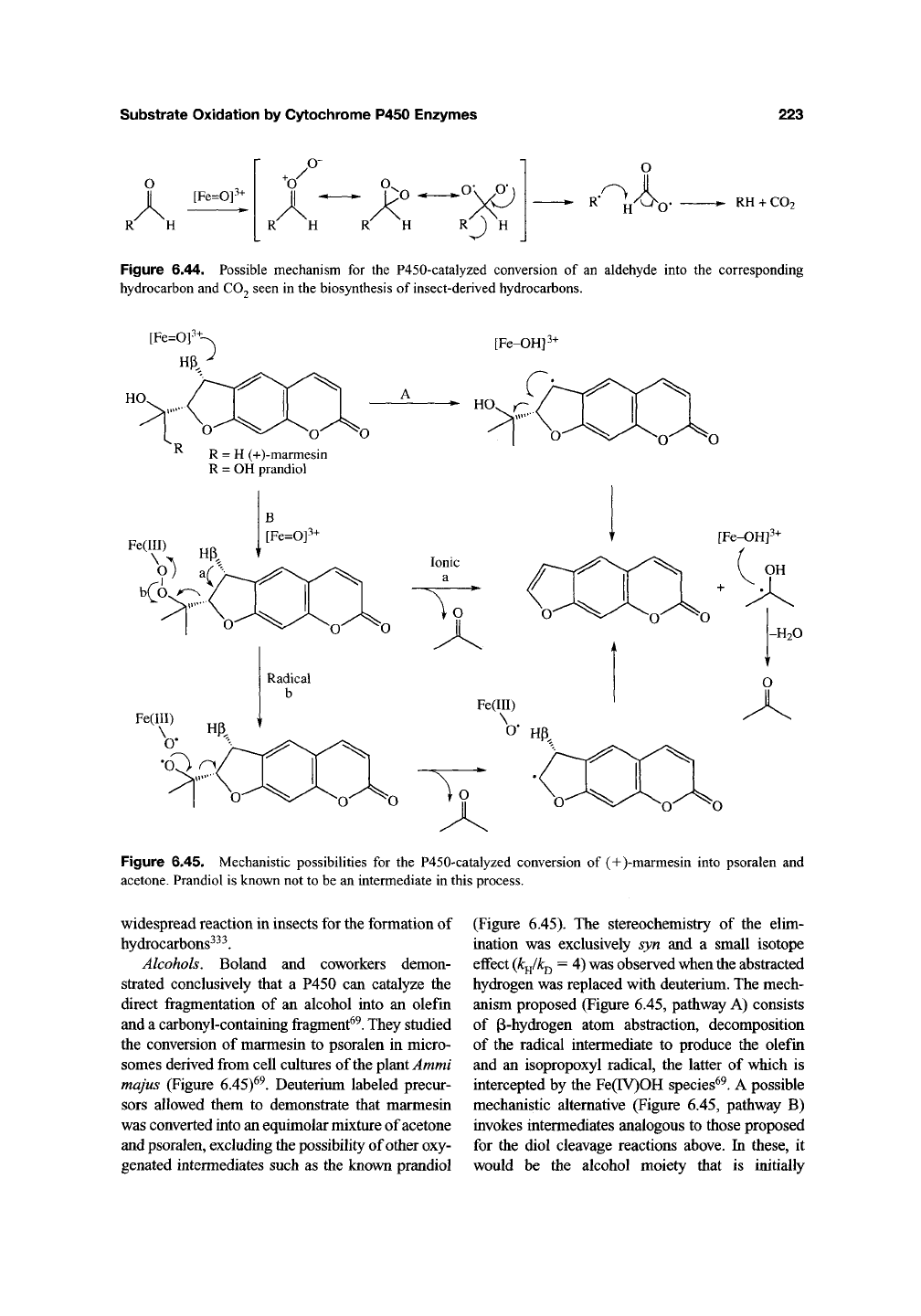
Substrate Oxidation by Cytochrome P450 Enzymes
223
A ^
•e=0]^^
^Q/
"X'^—W
^ R-^A
RH + CO2
Figure 6.44. Possible mechanism for the P450-catalyzed conversion of an aldehyde into the corresponding
hydrocarbon and CO2 seen in the biosynthesis of insect-derived hydrocarbons.
[Fe=0]3-t
HO.
R = H (+)-marmesin
R = OH prandiol
P^('II> HP t
b(^0.
B
[Fe=0]3+
Ionic
a
O
o*
[Fe-OH]3+
OH
Radical
b
Fe(III)
-H2O
A,
Figure 6.45. Mechanistic possibilities for the P450-cataIyzed conversion of (+)-marmesin into psoralen and
acetone. Prandiol is known not to be an intermediate in this process.
widespread reaction in insects for the formation of
hydrocarbons^^^.
Alcohols. Boland and coworkers demon-
strated conclusively that a P450 can catalyze the
direct fragmentation of an alcohol into an olefin
and a carbonyl-containing fragment^^. They studied
the conversion of marmesin to psoralen in micro-
somes derived from cell cultures of the plsnatAmmi
majus (Figure 6.45)^^. Deuterium labeled precur-
sors allowed them to demonstrate that marmesin
was converted into an equimolar mixture of acetone
and psoralen, excluding the possibility of other oxy-
genated intermediates such as the known prandiol
(Figure 6.45). The stereochemistry of the elim-
ination was exclusively syn and a small isotope
effect {k^lkj^ = 4) was observed when the abstracted
hydrogen was replaced with deuterium. The mech-
anism proposed (Figure 6.45, pathway A) consists
of P-hydrogen atom abstraction, decomposition
of the radical intermediate to produce the olefin
and an isopropoxyl radical, the latter of which is
intercepted by the Fe(IV)OH species^^. A possible
mechanistic alternative (Figure 6.45, pathway B)
invokes intermediates analogous to those proposed
for the diol cleavage reactions above. In these, it
would be the alcohol moiety that is initially
